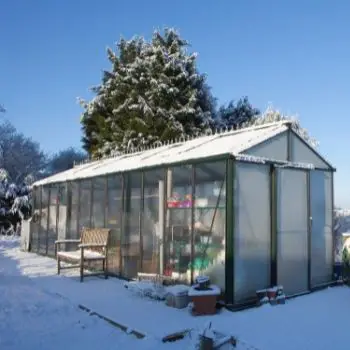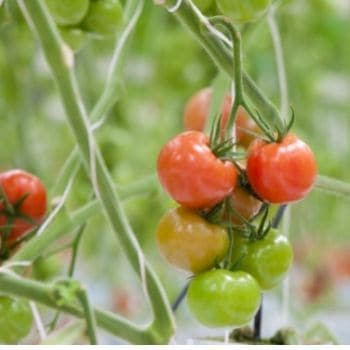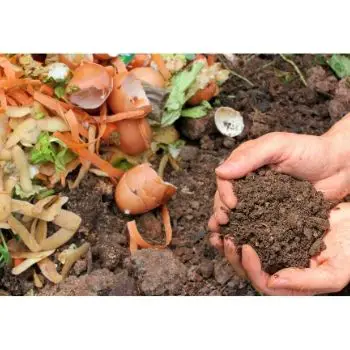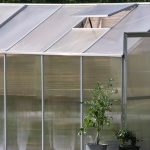As winter approaches, many greenhouse owners are wondering what to grow in their greenhouses. Growing in your greenhouse over the winter is a great way to extend your growing season. But, what to grow in a greenhouse in winter?
In cold climates, many vegetables can be grown in a greenhouse in winter to extend the growing season. Some plants that do especially well in greenhouses during winter months include lettuce, spinach, potatoes, broccoli, and carrots.
There are lots of things that can be grown in a greenhouse in winter, but it depends on what you have available to you and what you’re interested in growing. Here are some tips for getting started, and some plants, vegetables, and herbs to grow in a greenhouse over winter. Keep reading to find out more.
- Can you grow plants in a greenhouse over the winter
- What to Grow in a Greenhouse in Winter
- Can you grow tomatoes in a greenhouse in the winter
- Do you have to heat a greenhouse in the winter
- How can I heat my greenhouse for free in the winter
- Conditions for growing in the winter
- Winter Greenhouse Gardening Tips
- Conclusion
Can you grow plants in a greenhouse over the winter
Yes, you can grow plants in a greenhouse over the winter. Greenhouses are typically used to extend the growing season, but they can also be used to keep plants alive during the winter.
In order to grow plants in a greenhouse over the winter, you will need to make sure that the greenhouse is warm and that there is enough light. You may also need to provide some supplemental heat or light.
Related article:
What to Grow in a Greenhouse in Winter
The key to success in growing plants during wintertime in a greenhouse setting is choosing the best options. Some plants simply cannot handle the stress that comes with surviving the harsher climate and lower amounts of sunshine. Luckily, there are many that can so there are several options to choose from.

Poinsettias are a popular choice for winter greenhouses, as they add a splash of color to the space.
Many other flowering plants can also be grown in winter greenhouses, such as cyclamen and primroses.
Herbs like thyme and rosemary are also popular choices for winter greenhouses since they can be used in cooking.
It’s important to keep in mind that because it is winter, the growth of these plants will not compare to Spring, Summer, and even Fall growth.
Potatoes
One of the best choices for winter planting is potatoes because of how simple their care is and how little they require. You can plant them in sacks or in larger pots and buckets. For the best growth, it’s recommended to fill whatever container you’re planting them in with two parts garden soil and one part compost. This combination creates an ideal environment for potatoes to survive and grow through the winter.
You can begin this process in early winter, November or December, and with the right care, you’ll be ready to enjoy potatoes by March or April. The most important thing to look out for when growing potatoes is a drop in temperature. They’re susceptible to frost so it’s imperative to keep them warm is the outdoor temperature has a sudden or large drop.
Brussel Sprouts
We may not have wanted to eat our Brussel sprouts as a kid, but they make an excellent winter vegetable to grow in your greenhouse. In total, they take roughly 3-4 months to mature and are typically ready to harvest by March.
It’s best to harvest them when they reach 1-2 inches in diameter, especially if you’re going to use them for cooking. Be sure to harvest similar-sized sprouts so they have equal cooking times when it’s time to eat them, that is if you’re finally ready to eat your Brussel sprouts.
Carrots
Looking What to Grow in a Greenhouse in Winter, then Another great and simpler option for your greenhouse is carrots!
They can be planted in the fall and will be ready to harvest by the time the ground thaws, or once Spring arrives in your area. There are several varieties of carrots that can be grown, each with its own specific needs, so it’s important to do some research on the kinds of carrots you’ll be planting to find out if they’re compatible with the environment you can provide.
Spinach
Under the right conditions, spinach can easily become the gift that keeps on giving, all winter long. Not only does the vegetable grow rather quickly, but they also love cool weather. Take note that if the temperatures drop too low, you may find that the plant becomes dormant for some time. Worry not! This is normal and it will bounce right back once the temperatures rise again.
Because of its hardiness and comfortability in cooler temperatures, spinach is an ideal wintertime greenhouse plant that will surely produce plenty for you!
Lettuce & Similar Varieties
The wonderful thing about some varieties of lettuce and greens is that some of them are resistant to frost. Be sure to check for these when choosing the best seed.
It’s best to plant these seeds in the early fall and let them be throughout the winter months. Transplanting this vegetable will shock it and may stunt its growth entirely. The good news is, if left alone, they will not only survive winter but thrive in the greenhouse.
The ideal harvesting time for lettuce and similar greens is before they reach full maturity. You can also feel confident in mixing different varieties so come time to harvest, you have plenty of options to choose from.
Kale
This leafy, hardy vegetable can handle temperatures below freezing, certain varieties even more. If the temperature drops any lower for this plant, you’ll need to provide some kind of heat to ensure it doesn’t go into shock or fall completely dormant.
By planting and cropping Kale in successive cycles, you can easily harvest it year round. Fun fact: Did you know that Kale that’s grown during the winter months actually produces tastes sweeter because it produces higher levels of sugar to protect its cells from the harsher conditions?
Garlic
Are you a fan of garlic? If so, you’re in luck! Garlic navigates the winter months well and if planted in January can be ready to harvest by early March, depending on how early the soil is ready to be worked and if it needs to thaw.
If you plant garlic in a pot, you can also move it out of the greenhouse during warmer months and it will easily adapt to its new setting. If you choose to plant garlic in your greenhouse during the winter months though, make sure you choose a hardback variety rather than a soft neck variety. Hardneck varieties of garlic are hardier and can adapt much easier to the cold.
Pak Choi
This vegetable that originates in northeast Asia takes only 30 days to leaf and roughly 70 days to harvest. Because of the environment, it originates from, it can navigate colder and harsher elements better than most.
Pak choi is an excellent plant to consider, not only because of its ability to flourish during the winter, but also because of its nutrient-rich leaves. This plant is packed with vitamins and is sure to be a healthy addition to any meal.
Cabbage
If you’re able to keep your greenhouse at an optimal temperature and keep the environment conducive for more picky plants, cabbage does have the ability to do well. While it requires more attention and care, the pay off is worth all the work.
This plant is much more sensitive to temperature and will definitely require steady supervision but can handle the winter months if cared for properly.
Broccoli
Much like cabbage, this vegetable is more sensitive to temperature than most of the others on this list. Nevertheless, it is still a great option for winter planting in a greenhouse under the correct conditions.
If you do choose to plant broccoli, it’s best to start early in November if you’re looking for a Spring harvest. Broccoli is another plant than can be moved outdoors in warmer temperatures and handle the change very well.
Can you grow tomatoes in a greenhouse in the winter
When asked, What to Grow in a Greenhouse in Winter? the topic of tomatoes usually comes up.
You can grow tomatoes in a greenhouse in the winter but it can be expensive. Heating and supplemental lighting can add to the cost of running a greenhouse. There are also some types of tomatoes that are bred for growing in greenhouses, so you may want to choose those varieties.

Tomatoes are a warm-weather crop and they will not grow well if the temperature inside the greenhouse falls below 75 degrees Fahrenheit.
Some people choose to grow tomatoes in a greenhouse in the winter by using a heating system. Others use supplemental lighting to keep the temperature inside the greenhouse warm. Both of these methods can be expensive, so you will need to decide if it is worth the cost.
Do you have to heat a greenhouse in the winter
The short answer is yes, a greenhouse needs to be heated during the winter. Greenhouses work by trapping heat inside, and if the temperature inside falls below a certain level, the plants can start to suffer.
Heating a greenhouse can be done in a few different ways – you can use electric heating cables, gas heaters, or even wood-burning stoves. Whatever method you choose, it’s important to keep the greenhouse at a comfortable temperature so your plants can thrive.
How can I heat my greenhouse for free in the winter
There are a few different ways to heat your greenhouse for free in the winter. One way is to use insulation. This will help keep the warm air inside and the cold air outside.
Another way is to store thermal energy. This means that you will use something like solar panels or a wood stove to heat up some water, and then use that water to heat your greenhouse.
The final way is to use compost. This will help keep the temperature of the soil in your greenhouse warm. All of these methods are effective and can help you save money on heating costs.

Conditions for growing in the winter
All of these plants, vegetables, and herbs will show the most growth in the most ideal conditions.
Here are some of the most important tips to follow:
Keep Heat Locked in as Much as Possible
If your greenhouse isn’t heated, you can generate some heat sources of your own with things like electric heaters, heat pads place under pots or containers to warm the plant’s roots, and insulation.
You can also be sure to take advantage of the sun by creative passive solar bottles. The process for this is quite easy. All you’ll need are some clear water bottles, black paint, and water. Paint the bottle black and fill them with water. You can then scatter them around the plants in the greenhouse. The black paint will absorb any heat given off by the sun during the day and at night, that stored heat will automatically keep release to keep the plants warm.
Plant New Seeds in Pots
By planting the seeds in the pots you intend for them to stay in, there won’t be any added stress of transplanting them. Transplanting any kind of plant causes stress and can sometimes stunt growth if not done properly. This is something we hope to avoid altogether during winter as the conditions make things more difficult for these plants. By planting and prepping them in large enough pots early on, you are able to eliminate this risk completely.

Choose The Best Seed Varieties
Each plant has dozens of seed varieties and some are better than others for colder temperatures. When searching for the best seed variety, be sure to take note of which ones are better in colder weather, making them cold-tolerant. It’s also helpful to look for seed varieties that have shorter growing seasons.
If you want to know what vegetables to grow in a greenhouse in winter then check this vegetable multi-pack (Amazon link). It’s a collection of 16,000 seeds of 35 different vegetable varieties. I think it one of the best vegetable multi-packs around
Plan Properly
If you are limited to one greenhouse, it’s important to make sure that the plants you’re putting together require similar needs and can handle similar conditions. Mixing plants with different needs will only add stress and not end well for some. Setting yourself up from the beginning is key.
Winter Greenhouse Gardening Tips
Gardening and reaping the benefits of harvesting your own plants are activities you shouldn’t have to miss out on simply because the winter months have rolled around.
Luckily, there are several plants, herbs, and vegetables that can navigate through these months with the right level of care. Additionally, there are some helpful tips that can make this process somewhat more manageable.
Cleaning and Preparing Your Greenhouse
For optimal results and the best possible environment for your plants, your greenhouse will need to be fully prepped and cleaned before the planting process begins.
By cleaning the walls and roof, you’re removing potentially built-up mold, dirt, and algae. The removal of these unwanted toxins clears the air for your plants and also allows for more light and heat to come into your greenhouse. Your plants will thank you for this and express their gratitude through the production of more leaves!
Disinfect all of the structural components of your greenhouse with a solution of your choice. It is recommended to use garden-specific solutions that won’t leave behind toxins for your plants to become exposed to.
Lastly, be sure to vacuum, sweep, or both to ensure all of the fallen and remaining debris is completely removed from your greenhouse. You can then return your plants into the space and organize them in a fully ready and prepped greenhouse for them to live in all winter long.
Ventilation for a Winter Greenhouse
An often overlooked step in preparing a greenhouse for a long winter is ventilation. A common question asked is do greenhouses need ventilation? If you are able to ventilate your green hosue then please do.
Just like people, plants need access to clean air too. Without a properly ventilated space, plants can become trapped with too much oxygen, too little carbon dioxide, and even toxins that can sneakily find their way in.
One solution is to leave your greenhouse doors open at the start of the day and close them when the sun goes down. This also avoids too much humidity building up in their environment, causing mildew and even disease.
Insulation for a Winter Greenhouse
It’s an absolute must for your greenhouse to retain enough heat for your plants to survive. Providing supplementary heat, as mentioned above, is key in achieving this. It also helps the heat produced by the sun to remain in the greenhouse without escaping too quickly.
Harvest Efficiently

One of the biggest mistakes that gardeners make when harvesting plants in the winter is that they treat it the exact same way as they would a Spring or Summer harvest. Unlike these warmer weather harvests, winter harvests should be spread out and not done all at once.
It’s recommended to take into account the scheduling of each plant and be deliberate in when the ideal harvesting time is for each one specifically. By harvesting at the correct time, you’re enabling the plant to continue to grow at a steady rate and not stunt or shock the plant.
Conclusion
We took a look at what to grow in a greenhouse in winter? If you live in a cold climate and are looking for ways to extend your growing season, consider planting some of these vegetables in a greenhouse this winter. Not only will you get to enjoy fresh produce well into the colder months, but you’ll also be doing your part to help reduce food waste. Have you grown any of these plants in a greenhouse during winter? What tips would you share with other gardeners?


















